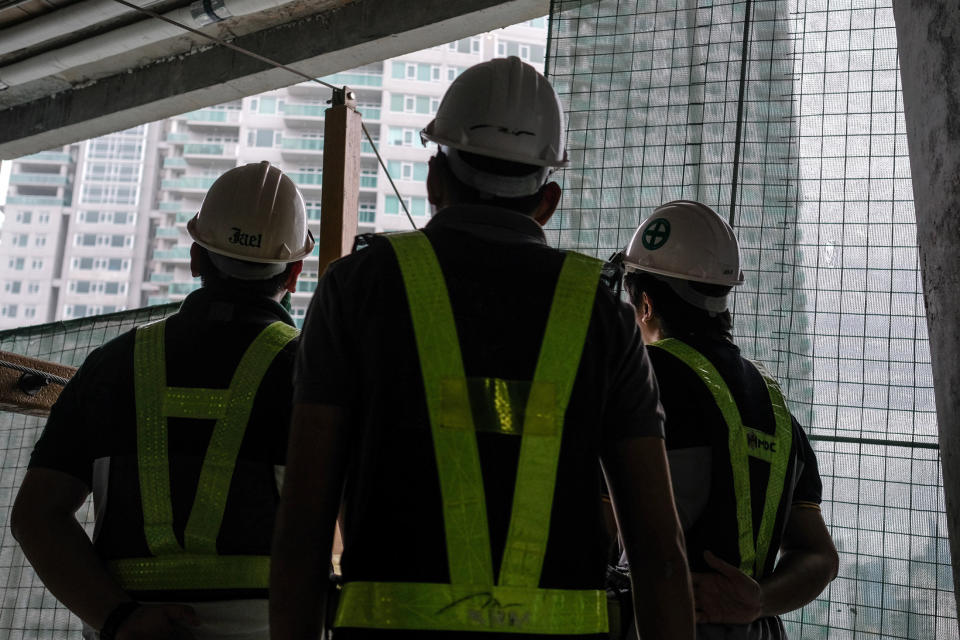Duterte’s $180 Billion Building Boom May Be Expats' Ticket Home

By Siegfrid Alegado
Philippine President Rodrigo Duterte’s plan to supercharge growth with a $180 billion (P8.9 trillion) infrastructure program is running into a roadblock: a lot of the people he needs to build all the roads, bridges, airports and railways are working abroad.
For decades, the Philippines has relied on money sent home from an army of nannies, maids, mariners, nurses and construction workers who can sometimes earn salaries of more than four times higher abroad. With Duterte raising billions of dollars in debt and taxes to upgrade the nation’s creaky transport network – ranked worse than that of Sri Lanka and Vietnam by the World Economic Forum – the loss of skilled personnel is causing a labor crunch that is pushing up wages and home prices.
“The labor shortage is an issue that’s hounding the construction industry,’’ said Jan Paul Custodio, senior director at property consultant Santos Knight Frank in Manila. “There’s definitely a need for further skills training, now more than ever. There needs to be a boost to any repatriation program.’’
The economy expanded 6.7 percent last year and the World Bank has said higher investment is critical to sustaining that pace of expansion. Under a policy named “Build, Build, Build,” Duterte plans to boost infrastructure spending to 7.3 percent of gross domestic product by 2022 from 6.3 percent this year.
Airport Terminal
First up is a new terminal at Clark International Airport – the former U.S. airbase north of Manila – that would triple its capacity to 12 million passengers a year. Other projects due to start this year include Manila’s first subway and a 102 kilometer (63 mile) railway in Mindanao, an island in the south of the country that is under martial law following a five-month battle with Islamic militants.
To help finance the bonanza, the government passed a tax law last month designed to add more than 180 billion pesos ($3.5 billion) to government coffers by 2020. But a large chunk of the financing will come from China and Japan, which are vying to win orders for their companies and build stronger ties with their Southeast Asian neighbor. The two have pledged $9 billion of loans and grants each.
Duterte has room to borrow after the previous administration ran a tight fiscal policy with a budget deficit goal of only 2 percent of GDP. The president, who took office in 2016, is seeking to widen that to 3 percent from 2018 to 2022.
“The Philippines can afford to do that, and I don’t see a problem in the next two years,” said Euben Paracuelles, an economist at Nomura Holdings Inc. in Singapore. “Further out, there lies the question.”
Million Deployments
The bigger challenge will be finding engineers and qualified staff to operate the cranes, earth movers and heavy equipment. More than a million Filipinos leave each year.
“The lack of skilled laborers poses an increasingly large constraint on the sector’s growth’’ resulting in project delays and cost overruns, according to Raphael Mok, senior analyst for Asia at BMI Research in Singapore. A failure to push through Duterte’s infrastructure plans could adversely affect the country’s growth prospects, he said.
The Philippines scored 51.8 out of 100 in BMI’s labor market risk index, which measures the availability, level of skill and cost of workers. That’s compared with 74.9 for Singapore, 58.3 for Malaysia and 58.2 for Thailand.
Delays
The labor gap has already caused some project delays in the private construction industry, leading to an increase in home and office prices, said Joey Bondoc, research manager at Colliers International Philippines in Manila. Of the 16,200 additional residential units that Colliers expected in Manila last year, only about 7,400 units were completed in the first three quarters.
The result will be a bidding war for construction workers, says Budget Secretary Benjamin Diokno. “Companies should be willing to adjust their wage rates,’’ he said.
To ease the shortage, the state agency Technical Education and Skills Development Authority is training more building workers and engineers.
“Tesda in the past six years failed to train construction workers and zeroed in on the service industry such as hotels, food and business process outsourcing,” said Ibarra Paulino, executive director at the Philippine Constructors Association Inc., a group of about 130 large building contractors.
But the Philippines isn’t the only place that needs more builders. In Japan, where wages are much higher, Tokyo is in the middle of preparations for the 2020 Olympic Games. Singapore is doubling the size of its mass transit system, while Indonesia, India and Malaysia are all on infrastructure drives to boost growth.
To fill vacancies, some Philippine developers are retraining employees or hiring more laborers from the countryside. Others, like 8990 Holdings Inc. are setting up their own training facilities for masonry, carpentry, welding and crane operation.
Part of the problem is that projects have become bigger and more complicated, requiring an upgrade of knowledge, said DMCI Holdings Inc. Chairman and President Isidro Consunji, whose company employs about 16,000 workers. DMCI offers skills-based bonuses to retain staff, “but only after we confirm that they’re really capable,” Consunji said.
Ultimately, one of the best sources of skilled workers, managers, and consultants is the 10 million Filipinos who live and work abroad, Economic Planning Undersecretary Rolando Tungpalan said in an interview in his office in Manila.
“If you offer the right price, they will come back,’’ he said.
To contact the reporter on this story: Siegfrid Alegado in Manila at aalegado1@bloomberg.net
To contact the editors responsible for this story: Nasreen Seria at nseria@bloomberg.net; Clarissa Batino at cbatino@bloomberg.net; Adam Majendie, Karl Lester M. Yap
© 2018 Bloomberg L.P

 Yahoo Finance
Yahoo Finance 